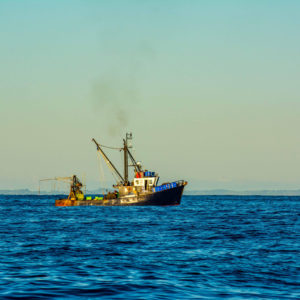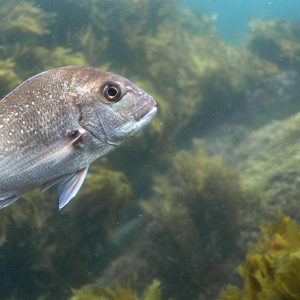Bottom trawling, the act of dragging chains across the seabed, has an adverse effect on the marine environment. In our most recent submissions responding to government fisheries proposals we have emphasised the need for the Minister to take those adverse effects into account by setting lower catch limits for fish species taken mainly by trawling.

We cannot expect to trawl our inshore waters for another 100 years and think that it will continue to support large populations of fish and provide for our social, economic and cultural wellbeings.
We need to up our game and start treating our marine environment, and ultimately the interests of future generations, with more respect.
Over the past month our fisheries and policy experts from the New Zealand Sport Fishing Council (NZSFC) have been working with other national representative organisations to develop submissions in response to proposals for South Island blue cod, North Island hāpuku and bass, North Island west coast snapper, gurnard around the top half of the country and southern bluefin tuna nationally. Any changes will apply from October 1st.
Here is a brief summary of those submissions.
Blue cod 3
On the east coast of the South Island blue cod are in trouble. Catch reductions are required. Recreational fishers have unfairly had their daily bag limit reduced, a choice they are willing to accept if there are reasonable cuts to commercial catch.
It’s no surprise that Canterbury fishers are upset because Fisheries New Zealand has introduced a ‘traffic light system’ that restricts the recreational daily limit to two blue cod per person, per day, while trawlers can continue to sweep past at will.
Fisheries NZ implemented the blue cod strategy including a traffic light system without discussing major changes with the blue cod working group, including recreational fishers. All the goodwill developed during the working group process has been incinerated and now there are serious concerns about non-compliance by recreational fishers.
The traffic light system is unfair and complex. Minister David Parker has a lot of factors to consider before he makes his decision for October 1st. We have submitted a range of recommendations on fairer catch settings, a review of the traffic light system, and banning bottom trawling from inshore waters.
Snapper 8
If the government is serious about its vision for ecosystem based management then we would expect the Minister’s upcoming decisions to provide for greater protection of the marine environment from harmful fishing practices.
The snapper fishery out west of the North Island needs a good dose of precautionary management as it has taken 33 years to rebuild to an abundant state. Proposals by Fisheries NZ to increase the commercial catch limit by up to 100 percent is out of line with the government’s stated direction. Assurances that such a large increase will not lead to more trawling are hard to fathom.
It is implausible that the Minister could increase the total allowable commercial catch from 1300 tonnes to 2600 tonnes and not expect more bottom trawling. After a series of meetings it is abundantly clear that locals and mana whenua do not want more trawling.
Trawl exclusion zones to protect māui dolphin, improved numbers of juvenile fish surviving to adulthood, and warming waters have all contributed to the rebuild of Snapper 8.
Information on the status of trevally is uncertain. The fishing impacts on juvenile hāpuku is largely ignored, and gurnard, john dory and tarakihi are all showing signs of over-exploitation.
Successful ecosystem management means we need to rebuild other species out west.
Given all the uncertainties, now is not the time to blithely increase fishing effort on the basis of a single stock assessment for a dominant species. A review in three years time would be useful. Meantime, the Minister needs to agree that no snapper catch increase this year is the ultimate, cautious response.
Gurnard 1
Good luck to anyone trying to find a gurnard in waters surrounding the top half of the North Island. Even commercial fishers who can trawl anywhere between south Waikato and East Cape have never been able to find as many gurnard as their quota allows. Where does that leave a rod and reel fisher? Empty handed a lot of the time.
There is such poor data on gurnard that we cannot rely on government science alone to guide decision-making. In our recent submission we urged the Minister to be bold. David Parker needs to reduce the total allowable commercial catch (TACC) to a level that will actually constrain harvest. That is the only way to rebuild depleted gurnard numbers.
Extending the māui dolphin trawl exclusion zone to cover west Northland will also help to protect inshore gurnard populations and allow whānau fishing from the shore a better chance of taking home a reasonable bag of fish for a day’s effort.
Hāpuku
Management of hāpuku and bass around the North Island can easily be described as a slow moving train wreck. Hāpuku once common on reefs in less than 50 m of water, are now found only on remote reefs and pinnacles. Depletion has been evident for decades yet little has been done to stem the targeting using increasingly clever technology.
Urgent action is required. Minister David Parker needs to set catch limits for hāpuku and bass that ensure a bycatch only fishery. No more targeting until the fishery rebuilds.
Catch limits alone won’t restore the fishery. The NZ Sport Fishing Council and other national representative organisations have agreed that area closures and recreational daily bag limit cuts will also be required.
Hāpuku and bass are slow growing, long lived fish so they will take years to rebuild to more natural levels. We can all contribute to their restoration but only if David Parker acts decisively now.
Southern bluefin tuna
Due to reasons unknown a new, more accessible fishery has developed for southern bluefin tuna off the east coast of the North Island. Since 2017 this winter fishery has both thrilled and tested the hearts of many.
Internationally the fishery is regrowing and New Zealand has been granted an extra 14 tonnes of annual catch for the next three years. The Minister, David Parker, must now decide who gets access to that fish.
The NZ Sport Fishing Council has submitted that setting the right allowance for a new recreational fishery is critical to avoiding allocation disputes in the future. Given that commercial fishers continue to under catch their allocation and the Minister’s obligation to manage all catch within the Total Allowable Catch, the Council advocates the 14 tonnes needs to be added to the recreational allowance from October 1st while retaining the one fish recreational daily bag limit.





